Paper Menu >>
Journal Menu >>
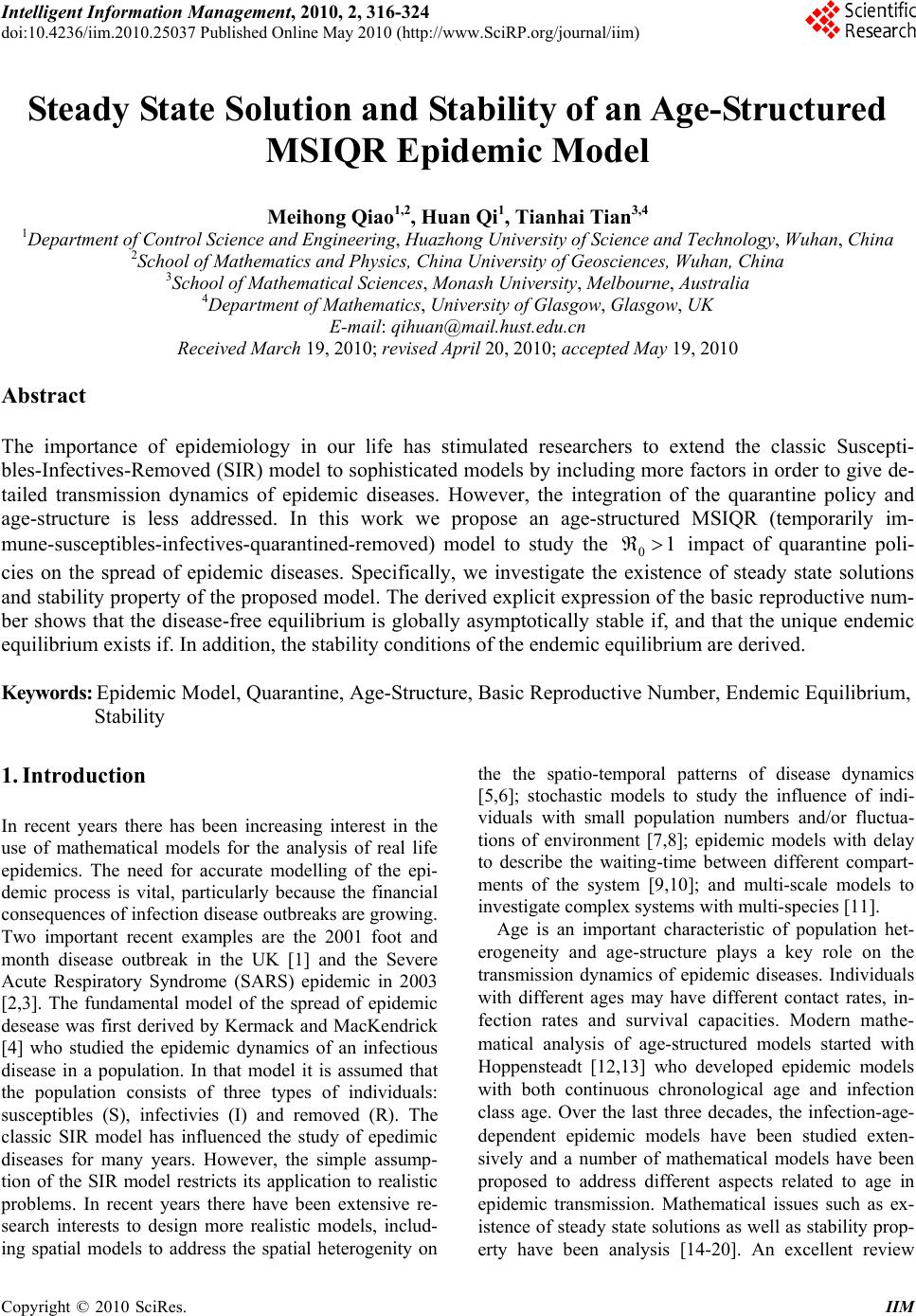 Intelligent Information Ma nagement, 2010, 2, 316-324 doi:10.4236/iim.2010.25037 Published Online May 2010 (http://www.SciRP.org/journal/iim) Copyright © 2010 SciRes. IIM Steady State Solution and Stability of an Age-Structured MSIQR Epidemic Model Meihong Qiao1,2, Huan Qi1, Tianhai Tian3,4 1Department of Control Science and Engineering, Huazho n g Universit y o f Science and Technol o gy, Wuhan, China 2School of Mathematics and Physics, China University of Geosciences, Wuhan, China 3School of Mathematical Sciences, Monash University, Melbourne, Australia 4Department of Mat hem at i cs, University of Gl a sgow, Gl asgow, UK E-mail: qihuan@mail.hust.edu .cn Received March 19, 2010; revised April 20, 2010; accepted May 19, 2010 Abstract The importance of epidemiology in our life has stimulated researchers to extend the classic Suscepti- bles-Infectives-Removed (SIR) model to sophisticated models by including more factors in order to give de- tailed transmission dynamics of epidemic diseases. However, the integration of the quarantine policy and age-structure is less addressed. In this work we propose an age-structured MSIQR (temporarily im- mune-susceptibles-infectives-quarantined-removed) model to study the 01 impact of quarantine poli- cies on the spread of epidemic diseases. Specifically, we investigate the existence of steady state solutions and stability property of the proposed model. The derived explicit expression of the basic reproductive num- ber shows that the disease-free equilibrium is globally asymptotically stable if, and that the unique endemic equilibrium exists if. In addition, the stability conditions of the endemic equilibrium are derived. Keywords: Epidemic Model, Quarantine, Age-Structure, Basic Reproductive Number, Endemic Equilibrium, Stability 1. Introduction In recent years there has been increasing interest in the use of mathematical models for the analysis of real life epidemics. The need for accurate modelling of the epi- demic process is vital, particularly because the financial consequences of infection disease outbreaks are growing. Two important recent examples are the 2001 foot and month disease outbreak in the UK [1] and the Severe Acute Respiratory Syndrome (SARS) epidemic in 2003 [2,3]. The fundamental model of the spread of epidemic desease was first derived by Kermack and MacKendrick [4] who studied the epidemic dynamics of an infectious disease in a population. In that model it is assumed that the population consists of three types of individuals: susceptibles (S), infectivies (I) and removed (R). The classic SIR model has influenced the study of epedimic diseases for many years. However, the simple assump- tion of the SIR model restricts its application to realistic problems. In recent years there have been extensive re- search interests to design more realistic models, includ- ing spatial models to address the spatial heterogenity on the the spatio-temporal patterns of disease dynamics [5,6]; stochastic models to study the influence of indi- viduals with small population numbers and/or fluctua- tions of environment [7,8]; epidemic models with delay to describe the waiting-time between different compart- ments of the system [9,10]; and multi-scale models to investigate complex systems with multi-species [11]. Age is an important characteristic of population het- erogeneity and age-structure plays a key role on the transmission dynamics of epidemic diseases. Individuals with different ages may have different contact rates, in- fection rates and survival capacities. Modern mathe- matical analysis of age-structured models started with Hoppensteadt [12,13] who developed epidemic models with both continuous chronological age and infection class age. Over the last three decades, the infection-age- dependent epidemic models have been studied exten- sively and a number of mathematical models have been proposed to address different aspects related to age in epidemic transmission. Mathematical issues such as ex- istence of steady state solutio ns as well as stability prop- erty have been analysis [14-20]. An excellent review 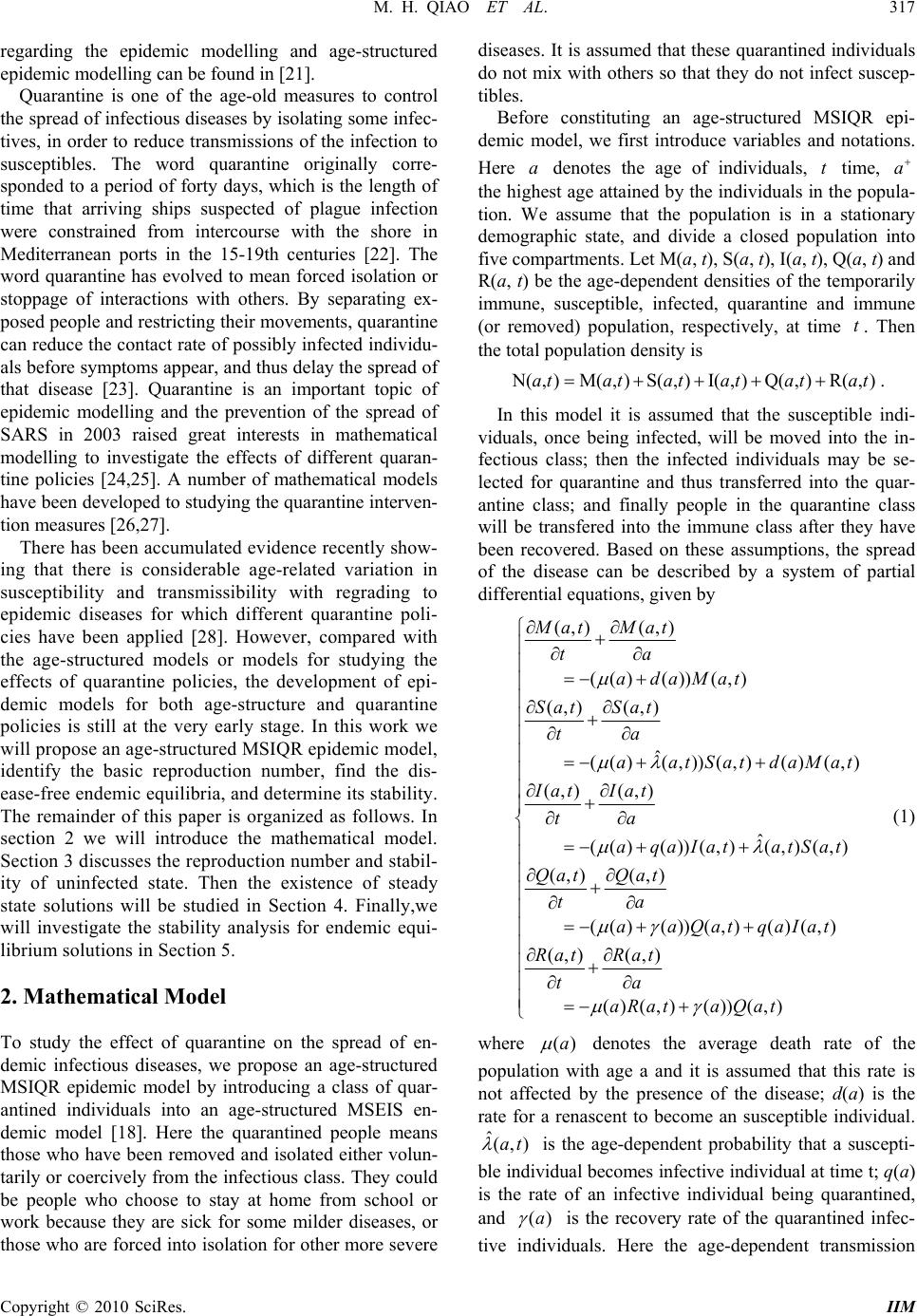 M. H. QIAO ET AL. 317 regarding the epidemic modelling and age-structured epidemic modelling can be found in [21]. Quarantine is one of the age-old measures to control the spread of infectious diseases by isolating some infec- tives, in order to reduce transmissions of the infection to susceptibles. The word quarantine originally corre- sponded to a period of forty days, which is the length of time that arriving ships suspected of plague infection were constrained from intercourse with the shore in Mediterranean ports in the 15-19th centuries [22]. The word quarantine has evolved to mean forced isolation or stoppage of interactions with others. By separating ex- posed people and restricting their movements, quarantine can reduce the contact rate of possibly infected individu- als before symptoms appear, and thus delay the spread of that disease [23]. Quarantine is an important topic of epidemic modelling and the prevention of the spread of SARS in 2003 raised great interests in mathematical modelling to investigate the effects of different quaran- tine policies [24,25]. A number of mathematical models have been developed to studying th e quaran tine inter ven- tion measures [26,27]. There has b een accumulat ed evidence r ecently show- ing that there is considerable age-related variation in susceptibility and transmissibility with regrading to epidemic diseases for which different quarantine poli- cies have been applied [28]. However, compared with the age-structured models or models for studying the effects of quarantine policies, the development of epi- demic models for both age-structure and quarantine policies is still at the very early stage. In this work we will propose an age-structured MSIQR epidemic model, identify the basic reproduction number, find the dis- ease-free endemic equilibria, and determine its stability. The remainder of this paper is organized as follows. In section 2 we will introduce the mathematical model. Section 3 discusses the reproduction number and stabil- ity of uninfected state. Then the existence of steady state solutions will be studied in Section 4. Finally,we will investigate the stability analysis for endemic equi- librium solutions in Section 5. 2. Mathematical Model To study the effect of quarantine on the spread of en- demic infectious diseases, we propose an age-structured MSIQR epidemic model by introducing a class of quar- antined individuals into an age-structured MSEIS en- demic model [18]. Here the quarantined people means those who have been removed and isolated either volun- tarily or coercively from the infectious class. They could be people who choose to stay at home from school or work because they are sick for some milder diseases, or those who are forced into isolation for other more severe diseases. It is assumed that these quarantined individuals do not mix with others so that they do not infect suscep- tibles. Before constituting an age-structured MSIQR epi- demic model, we first introduce variables and notations. Here denotes the age of individuals, t time, aa the highest age attain ed by the individuals in the popula- tion. We assume that the population is in a stationary demographic state, and divide a closed population into five compartments. Let M(a, t), S(a, t), I(a, t), Q(a, t) and R(a, t) be the age-dependent densities of the temporarily immune, susceptible, infected, quarantine and immune (or removed) population, respectively, at time . Then the total population density is t N (,)M(,)S(,)I(,)Q(,)R(,)atatat atatat . In this model it is assumed that the susceptible indi- viduals, once being infected, will be moved into the in- fectious class; then the infected individuals may be se- lected for quarantine and thus transferred into the quar- antine class; and finally people in the quarantine class will be transfered into the immune class after they have been recovered. Based on these assumptions, the spread of the disease can be described by a system of partial differential equations, given by (,) (,) (()()) (,) (,) (,) ˆ (()(,))(,)() (,) (,) (,) ˆ (() ())(,)(,)(,) (,) (,) (() ())(,)()(,) (,) MatMat ta adaMat Sat Sat ta aatSatdaMa Iat Iat ta aqa IatatSat Qat Qat ta aaQatqaIat Rat t t (,) ()(,)()) (,) Rat a aRata Qat (1) where ()a denotes the average death rate of the population with age a and it is assumed that this rate is not affected by the presence of the disease; d(a) is the rate for a renascent to become an susceptible individual. is the age-dependent probability that a suscepti- ble individual becomes infective individual at time t; q(a) is the rate of an infective individual being quarantined, and ˆ(,)at ()a is the recovery rate of the quarantined infec- tive individuals. Here the age-dependent transmission Copyright © 2010 SciRes. IIM 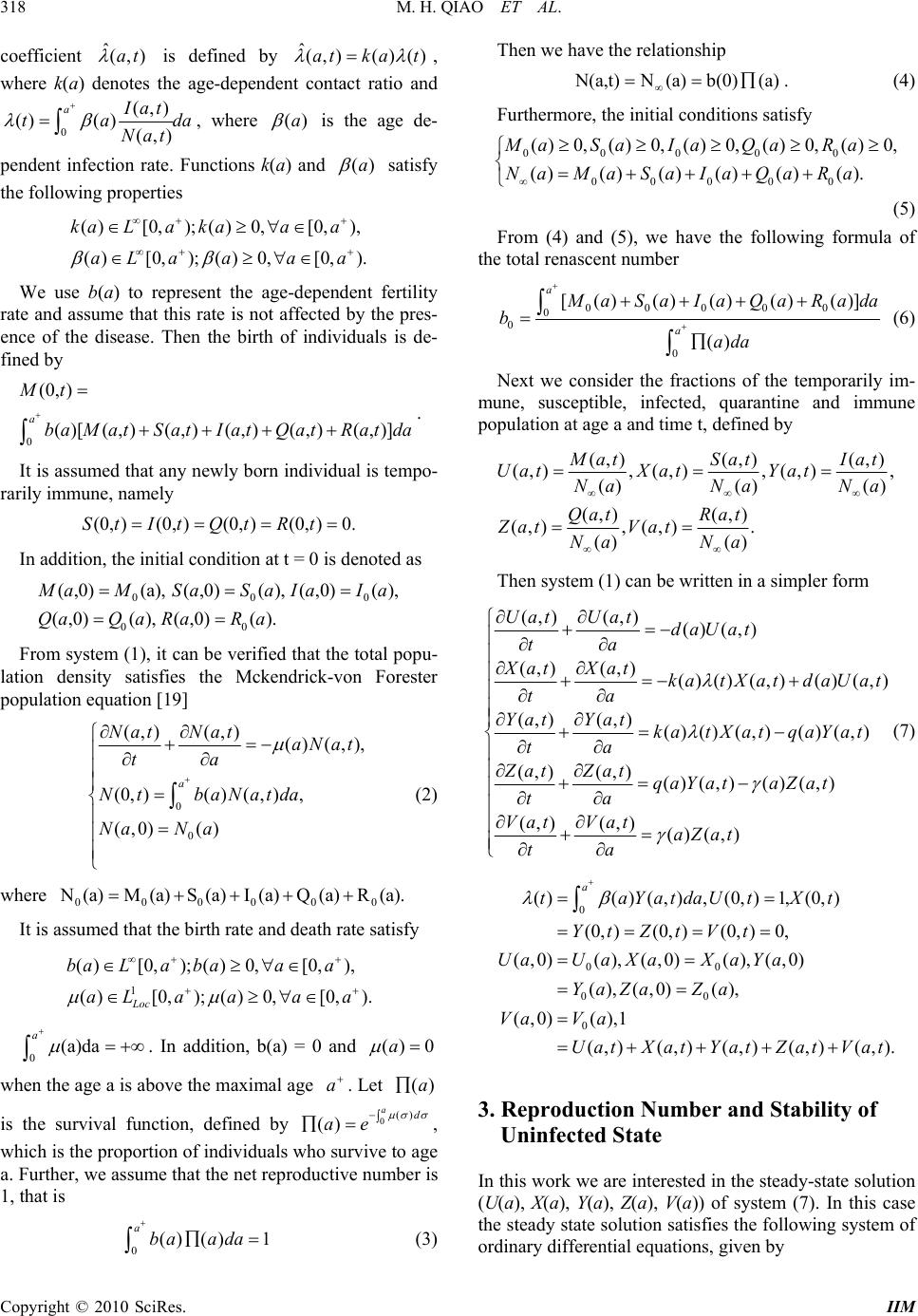 318 M. H. QIAO ET AL. coefficient is defined by ˆ(,)at ˆ(,) ()()atka t , where k(a) denotes the age-dependent contact ratio and 0 (, ( )(, Ia ta Na ) () ) atda t , where ()a is the age de- pendent infection rate. Functions k(a) and ()a satisfy the following properties () [ () [ L aL (,)M at (0,)St ) ( ) () 0,);() 0 0,); () kaa ka a a , 0, Q () ). [0, ), [0,). a a a a (,) (,)]atRatda (0,) 0.Rt 0 , (,0)(), We use b(a) to represent the age-dependent fertility rate and assume that this rate is not affected by the pres- ence of the disease. Then the birth of individuals is de- fined by 0 (0, ) ( )[( ,)(,) a Mt baS atIat . It is assumed that any newly born individual is tempo- rarily immune, namely (0,) (0,)It Qt In addition, the initial co ndition at t = 0 is denoted as 00 00 (,0a), (,0) (,0, (,0)( M aM Q a Sa QaRa R S a aIaIa From system (1), it can be verified that the total popu- lation density satisfies the Mckendrick-von Forester populat i on eq u a t i on [1 9] 0 0 (, (0, ) (,0 Nat Nt Na 00 ) (,) ( )( ) () a Nat ta baN N a () (,), , aNat da 00 , )at 0 (2) where 0 N (a) M 1 () [0 () Loc L aL a (a)S (a)I (a) , 0, a Q (a)R(a). [0, ), [0,). a a a () 0a It is assumed that the birth rate and dea th rate satisfy ,);() 0 [0,);() baa ba a a 0(a)d a . In addition, b(a) = 0 and when the age a is above the maximal age . Let a(a) is the survival function, defined by 0() () ad ae , which is the proportion of individuals who survive to age a. Further, we assume that the net reproductive number is 1, that is 0() ()ba ada1 a (3) Then we have the relati onship N (a,t)N (a)b(0)(a) . (4) Furthermore, the initial conditions satisfy 000 00 000 00 () 0,() 0,()0,() 0,() 0, ()()()()()(). Ma Sa IaQa Ra NaMaSa IaQaRa (5) From (4) and (5), we have the following formula of the total renascent nu mber 000 00 0 0 0 [()() ()()()] () a a M aSaIaQaRada bada (6) Next we consider the fractions of the temporarily im- mune, susceptible, infected, quarantine and immune population at age a and time t, defined by (,)(,) (,) (,),(,) ,(,) , ()() () (,) (,) (,), (,). () () M atSat Iat UatXat Yat NaNaNa Qat Rat Zat Vat Na Na Then system (1) can be written in a simpler form (,)(,) () (,) (,)(,)()()(,)() (,) (,)(,)()() (,)()(,) (,)(,) ()(,) ()(,) (,)(,)()(,) Uat UatdaUat ta Xat Xatka tXat daUat ta YatYat katXat qaYat ta ZatZatqaYat aZat ta VatVataZat ta (7) 0 00 00 0 ()()(, ),(0, )1,(0, ) (0, )(0, )(0, )0, (,0)(),(,0)(),(,0) (), (,0)(), (,0) (),1 (,)(,) (,)(,)(,). a taYatdaUtXt YtZtVt UaUaXaXa Ya YaZa Za VaVa UatXat YatZat Vat 3. Reproduction Number and Stability of Uninfected State In this work we are interested in th e steady-state solution (U(a), X(a), Y(a), Z(a), V(a)) of system (7). In this case the steady state solution satisfies the fo llowing system of ordinary differential equations, given by Copyright © 2010 SciRes. IIM 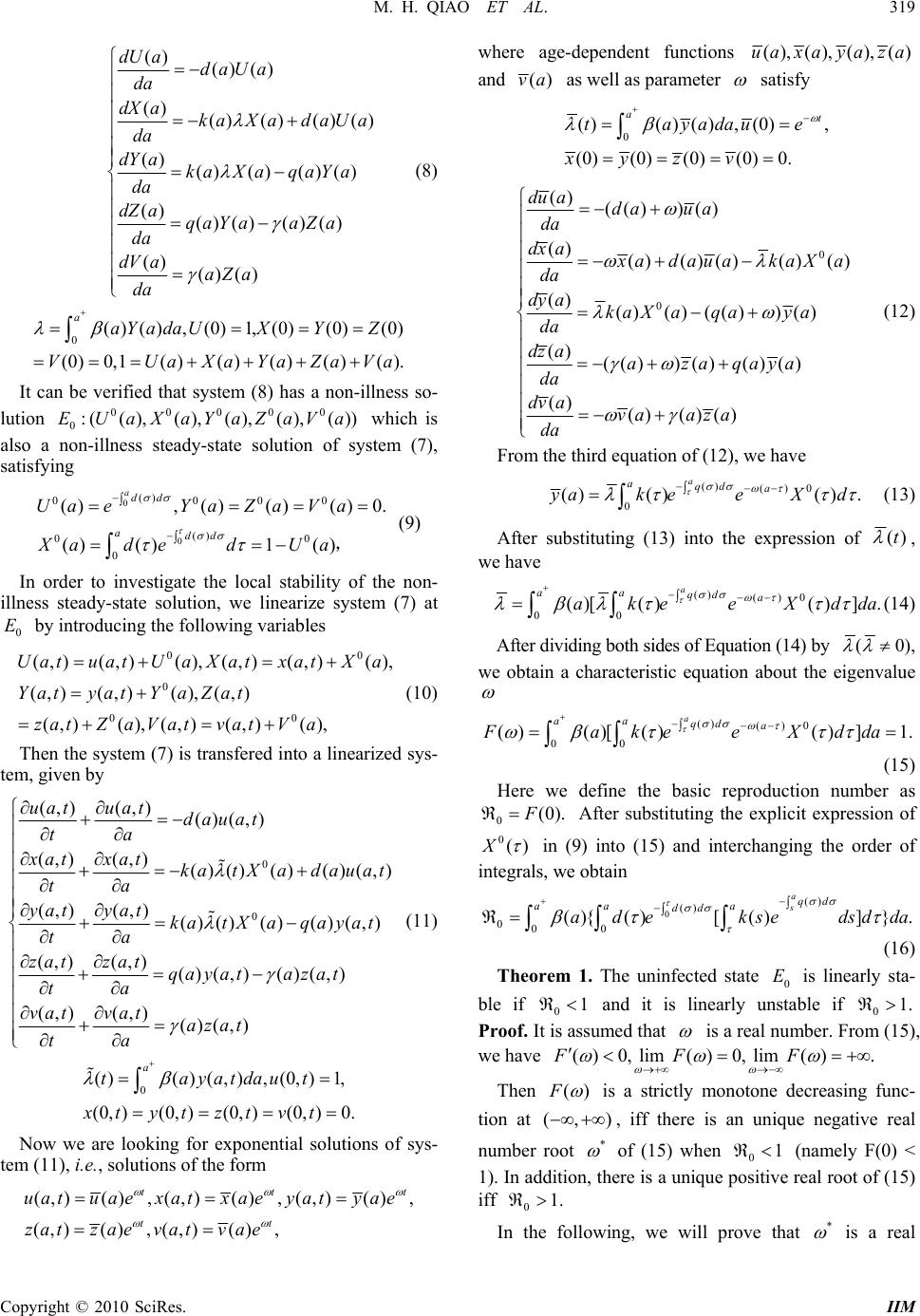 M. H. QIAO ET AL. 319 () ()() () ()()()() () ()() ()() () ()() ()() () ()( ) dU adaUa da dX aka XadaUa da dY aka XaqaYa da dZ aqaYa aZa da dV aaZa da (8) 0()(),(0)1, (0)(0)(0) (0) 0,1()()()()(). aaYadaUX YZ VUaXaYaZaV a 0 0 It can be verified that system (8) has a non-illness so- lution which is also a non-illness steady-state solution of system (7), satisfying 00000 0:( (),(), (),(),())EUaXaYaZaVa 0 0 () 0000 () 0 0 (),()()() 0. ()()1 () add add UaeYaZa Va Xad edUa , (9) In order to investigate the local stability of the non- illness steady-state solution, we linearize system (7) at by introducing the following variables 0 E 0 0 00 (,)(,)(),(,)(,)(), (,)(,)(),(,) (,)(), (,)(,)(), UatuatUaX atxatXa YatyatYaZat zatZaVatvatVa (10) Then the system (7) is transfered into a linearized sys- tem, given by 0 0 (,) (,)()(,) (,)(,)()() ()()(,) (,)(,) ()() ()()(,) (,)(,) ()(,) ()(,) (,)(,) ()(,) uat uatdauat ta xat xatkatX adauat ta yatyat katX aqayat ta zatzat qayatazat ta vat vatazat ta (11) 0 ()( )( ,),(0,)1, (0,)(0, )(0, )(0, )0. a tayatdaut xtytzt vt Now we are looking for exponential solutions of sys- tem (11), i.e., solutions of the form (,)(),(,)(),(,)() (,)(),(,)(), tt tt uatuae xatxaeyatyae zatzae vatvae where age-dependent functions (),(), (),()ua xaya za and ()va as well as parameter satisfy 0 ()()(),(0), (0)(0)(0)(0) 0. at tayadaue xyzv 0 0 () (() )() () ()()()() () () ()() (())() () (())()()() () () ()() du ada ua da dx a x adaua kaXa da dy akaXaqaya da dz aazaqaya da dv avaaza da (12) From the third equation of (12), we have () ()0 0 ()()() . a aqd a y akeeX d (13) After substituting (13) into the expression of )(t , we have () ()0 00 ()[()()] . a aa qd a akee Xdd a (14) After dividing both sides of Equation (14) by (0) , we obtain a characteristic equation about the eigenvalue () ()0 00 ()()[()() ]1. a aaqd a FakeeXdd a (15) Here we define the basic reproduction number as 0(0).F 0()X After substituting the explicit expression of in (9) into (15) and interchanging the order of integrals, we obtain 0() () 000 (){()[()]} . a sqd aa a dd adeksedsdda (16) Theorem 1. The uninfected state is linearly sta- ble if 0 E 01 and it is linearly unstable if 01. Proof. It is assumed that is a real number. From (15), we have ()0,lim) 0,l()F (FFim. , t Then ()F is a strictly monotone decreasing func- tion at (,) * , iff there is an unique negative real number root of (15) when (namely F(0) < 1). In addition, there is a unique positive real root of (15) iff 01 01. In the following, we will prove that * is a real Copyright © 2010 SciRes. IIM 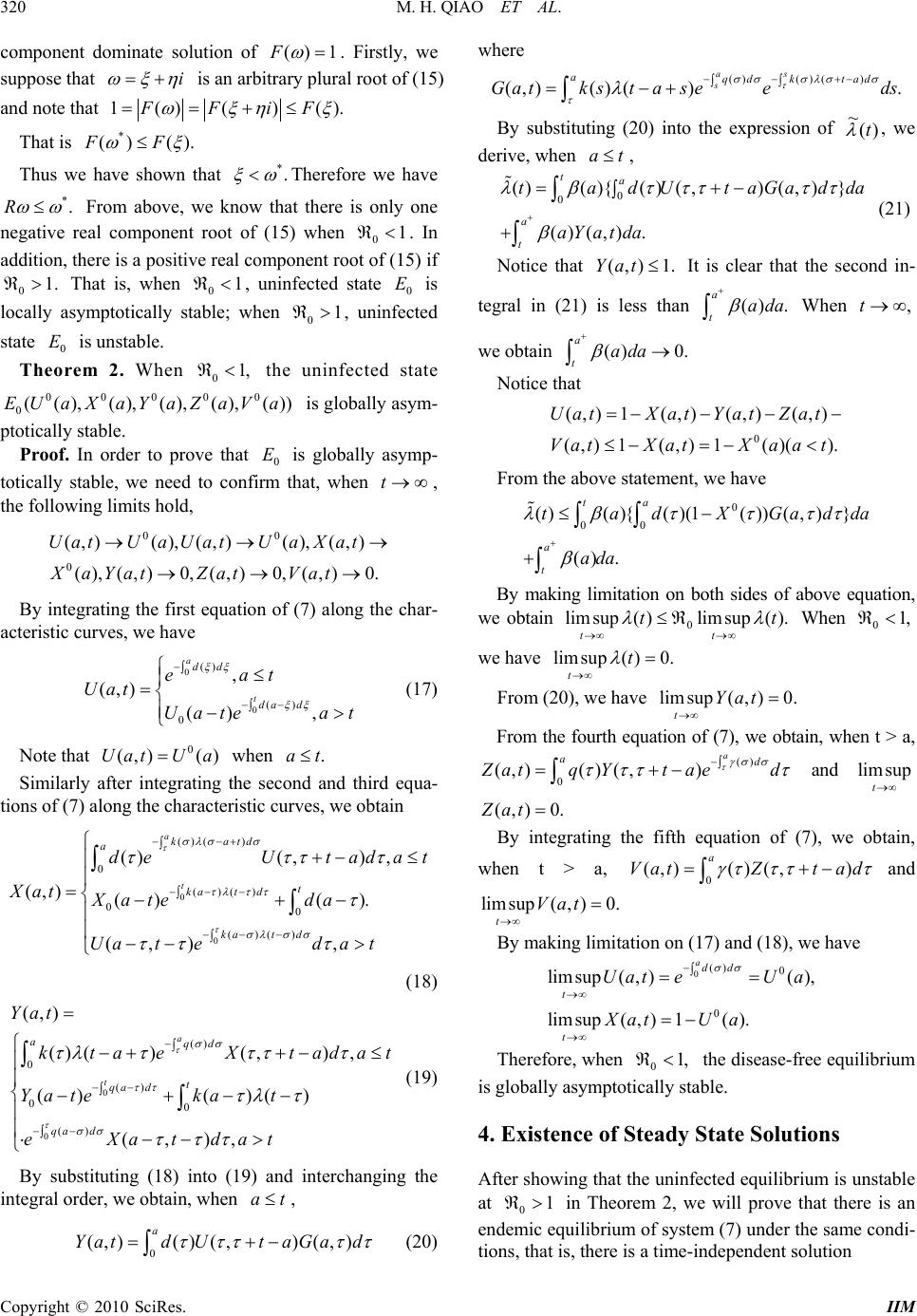 320 M. H. QIAO ET AL. component dominate solution of () 1F . Firstly, we suppose that i is an arbitrary plur al root of (15) and note that 1() ().FF)(iF . That is * () ()FF Thus we have shown that *. Therefore we have *.R 01. 0 E From above, we know that there is only one negative real component root of (15) when . In addition, there is a positive real component root of (15) if That is, when , uninfected state is locally asymptotically stable; when , uninfected state is unstable. 01 0 E 0 1 01 Theorem 2. When the uninfected state is globally asym- 01, 0 ( ),Z aV 0000 0(( ),( ),( ),( ))EU aXaY aa ptotically stable. Proof. In order to prove that is globally asymp- totically stable, we need to confirm that, when , the following limits hold, 0 E t 00 0 (,)(),(,)(),(,) (),(,) 0,(,) 0,(,)0. UatU aUatUaXat XaYatZat Vat t By integrating the first equation of (7) along the char- acteristic curves, we have 0 0 () () 0 , (,) () , a t dd dad eat Uat Uateat (17) Note that when 0 (,) ()UatU a.at Similarly after integrating the second and third equa- tions of (7) along the characteristic curves, we obtain 0 0 ()() 0 ()() 00 ()() ()(,), (,) ()( ). (,) , a t katd a t katd katd deU tadat Xat Xateda Uated at (18) 0 0 () 0 () 00 () (,) ()()(,) , ()()() (,), a t aqd t qad qa d Yat ktaeX tada Yatekat eXatdat (19) By substituting (18) into (19) and interchanging the integral order, we obtain, when , at 0 (,)() (,) (,) a YatdUt aGad (20) where ()()() (,)()(). as s aqd ktad Gatkstaseeds By substituting (20) into the expression of )( ~ t , we derive, when at , 0 0 ()(){()(,)(,)} ()(,) . ta a t tadUtaGad aYatda da (21) Notice that (,) 1.Yat It is clear that the second in- tegral in (21) is less than When we obtain () . a tada ,t () 0ada . a t Notice that 0 (,) 1(,)(,)(,) (,)1(,) 1()(). UatXat YatZat VatXatXa at da From the above statement, we have 0 00 ()(){()(1( ))( ,)} () . ta a t tadXGad ada By making limitation on both sides of above equation, we obtain 0 limsup()limsup(). tt tt When 01, we have limsup()0. tt From (20), we have limsup(, )0. tYat From the fourth equation of (7), we obtain, when t > a, () 0 (,)()(,) a ad Z atqYt aed (,)0.Zat and limsup t By integrating the fifth equation of (7), we obtain, when t > a, 0 (,) ()(,) a VatZt ad and limsup(, )0. tVat By making limitation on (17) and (18), we have 0() 0 0 limsup(, )(), limsup(, )1(). add t t UateUa XatUa Therefore, when 01, the disease-free equilibrium is globally asymptotically stable. 4. Existence of Steady State Solutions After showing that the uninfected equilibrium is unstable at 01 in Theorem 2, we will prove that there is an endemic equilibrium of system (7) under the same condi- tions, that is, there is a time-independent solution Copyright © 2010 SciRes. IIM 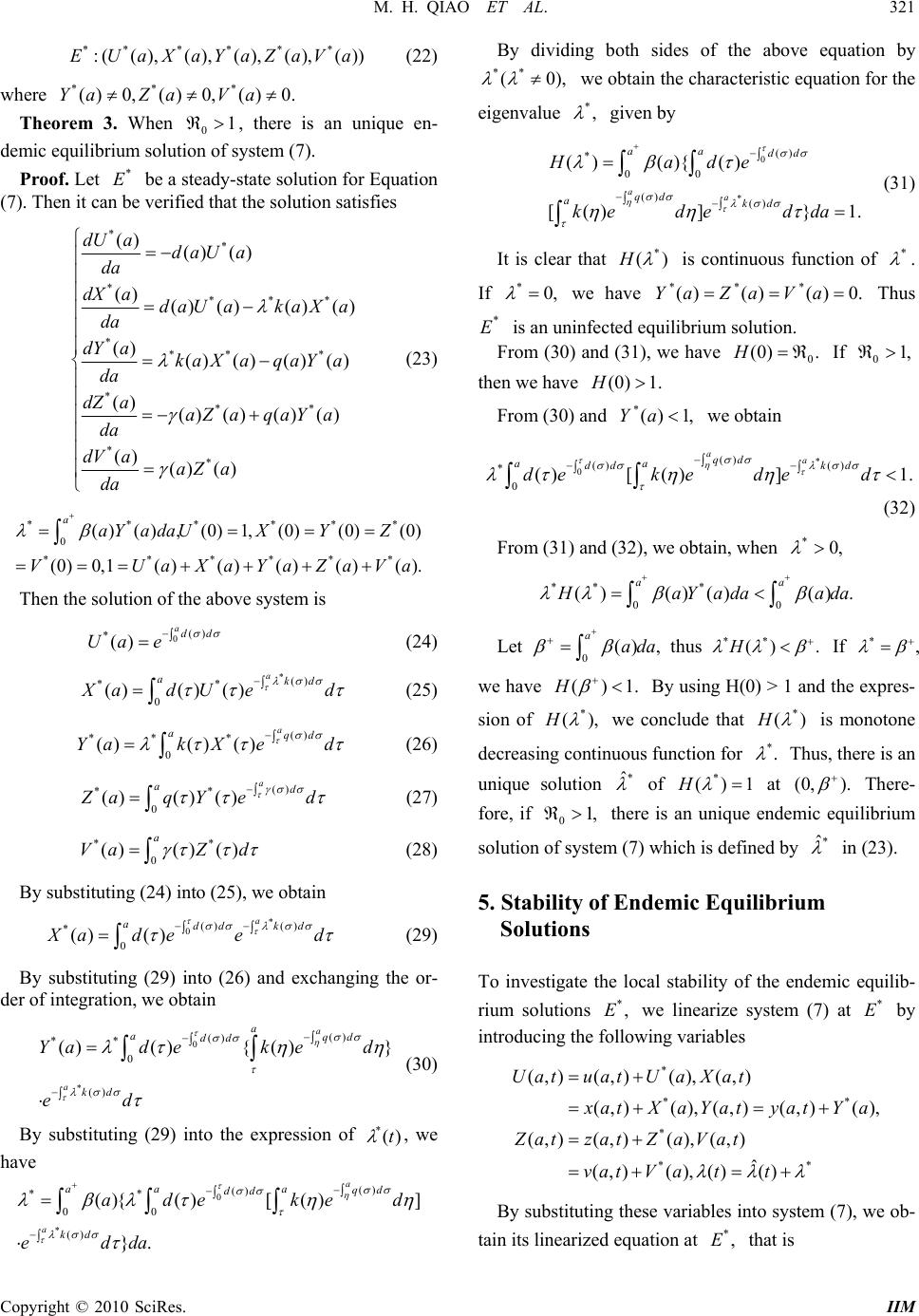 M. H. QIAO ET AL. 321 *** ** * :( (),(), (),(), ())EUaXaYaZaVa (22) where *** () 0,() 0,() 0.YaZaVa Theorem 3. When , there is an unique en- demic equilibrium solution of system (7). 01 Proof. Let be a steady-state solution for Equation (7). Then it can be verified that the solution satisfies * E ** **** *** * *** ** () () () () () ()()() () ()()() () () ()()()() () ()() dU adaU a da dX adaU akaXa da dY akaXaqaY a da dZ aaZaqaY a da dV aaZa da (23) ***** 0 ***** ()(),(0) 1,(0)(0)(0) (0) 0,1()()()()(). aaY adaUXYZ VUaXaYaZaV * * a Then the solution of the above system is 0() *()add Ua e (24) *() ** 0 ()() ()a akd X adUed (25) () ** * 0 ()()()a aqd Yak Xed (26) () ** 0 ()()()a ad Z aqYe d (27) ** 0 ()() () a VaZ d (28) By substituting (24) into (25), we obtain * 0() () * 0 () ()a add kd X ade ed (29) By substituting (29) into (26) and exchanging the or- der of integration, we obtain 0 * () () ** 0 () ()(){ ()} a a a aqd dd kd Yad eked ed (30) By substituting (29) into the expression of , we have )( *t 0 * () () ** 00 () (){()[ ()] }. a a aa a qd dd kd adeke d edda By dividing both sides of the above equation by we obtain the characteristic equation for the eigenvalue ** (0 ), *, given by 0 * () * 00 () () ()(){ () [()]} 1 aa aadd qd akd Hade k ededda . (31) It is clear that * ()H is continuous function of * . If *0, we have Thus is an uninfected equilibrium solution. *** ()()() 0.YaZa Va * EFrom (30) and (31), we have If 0 (0) .H 01, then we have (0) 1.H From (30) and *() 1,Ya we obtain * 0() () () * 0()[ ()]1. aa qd aa dd kd deke ded (32) From (31) and (3 2) , we obtain , when *0, ** * 00 ()() ()() . aa H aY adaada Let thus 0() , aada ** () .H If * , we have ()1.H By using H(0) > 1 and the expres- sion of * (),H we conclude that * ()H is monotone decreasing continuous function for *. Thus, there is an unique solution * ˆ of at * ()1 (0,H). There- fore, if 01, there is an unique endemic equilibrium solution of system (7) which is defined by * ˆ in (23). 5. Stability of Endemic Equ il ib ri um Solutions To investigate the local stability of the endemic equilib- rium solutions we linearize system (7) at by introducing the following variables *,E* E * ** * ** (,)(,)(), (,) (,)(), (,)(,)(), (,)(,)(), (,) ˆ ( ,)(),()() UatuatUa Xat x atXaYatyatYa ZatzatZ aVat vatV att By substituting these variables into system (7), we ob- tain its linearized equation at that is *,E Copyright © 2010 SciRes. IIM 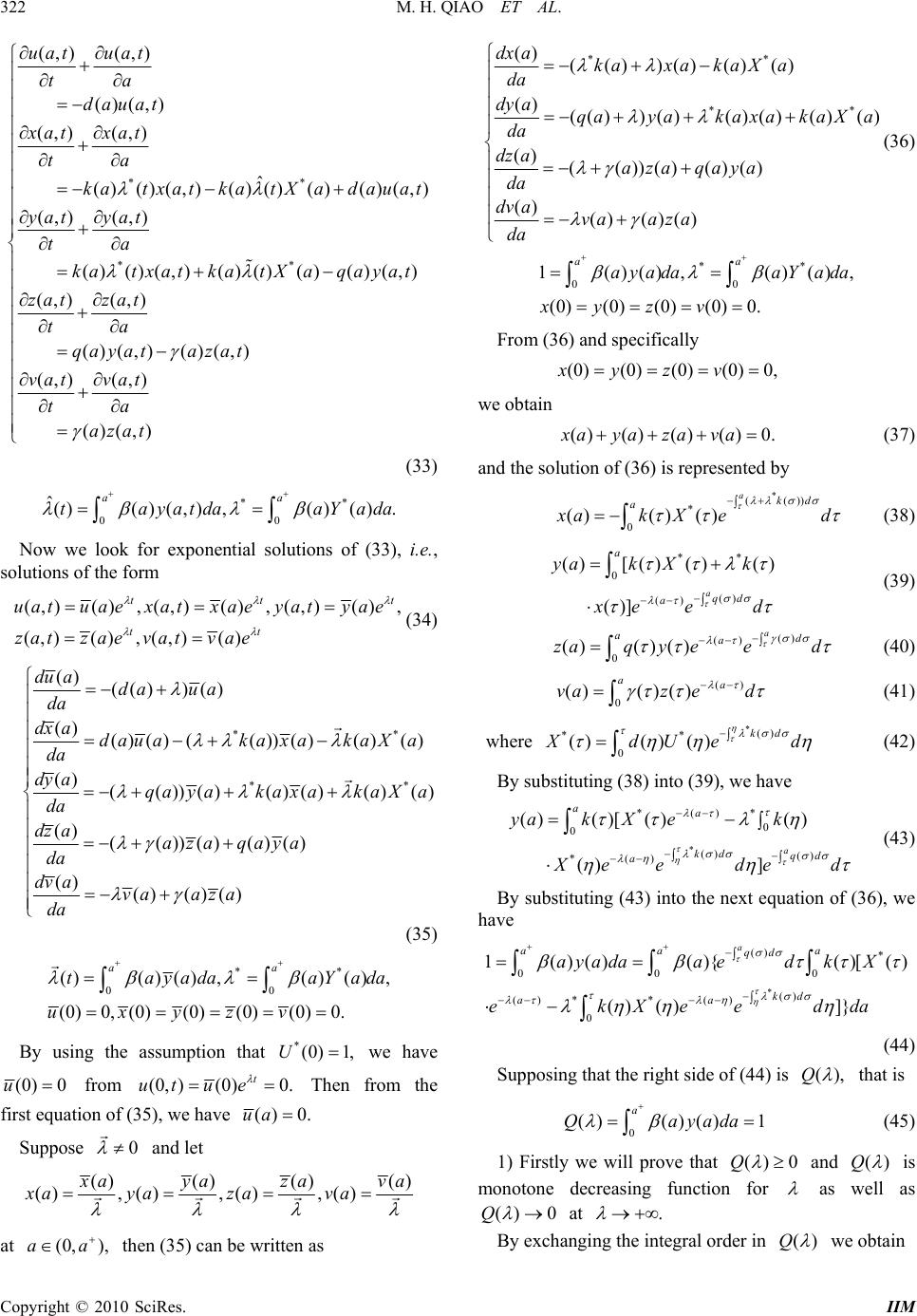 322 M. H. QIAO ET AL. ** ** (,) (,) ()(,) (,) (,) ˆ () ()(,)()()()()(,) (,)(,) () ()(,)()()()()(,) (,)(,) ()(,)()(,) (, uat uat ta dauat xat xat ta katxatkatXadauat yat yat ta katxatkatXaqayat zat zat ta qayat azat va )(,) ()(,) tvat ta azat (33) ** 00 ˆ()()(,) ,() (). aa tayatda aYa da Now we look for exponential solutions of (33), i.e., solutions of the form (,)() ,(,)() ,(,)() , (,)() ,(,)() tt tt uatuae xatxae yatyae zatzae vatvae t (34) ** * () (() )() () ()() (())()()() () (())()()()() () () (())()()() () () ()() du ada ua da dx adauakaxakaXa da dy aqa yakaxakaXa da dz aaza qaya da dv ava aza da * (35) ** 00 ()( )( ),( )(), (0) 0,(0)(0)(0)(0) 0. aa tayadaaYa uxyzv da By using the assumption that we have *(0) 1,U (0) 0u from (0,)(0)0. t ut ue Then from the first equation of (35), we have () 0.ua Suppose and let 0 ()()() () () ,(),() ,() x ayazav xayazava a at then (35) can be written as (0, ),aa ** ** () (())()()() () (())()()()()() () (())() ()() () () ()() dx akaxakaX a da dy aqayakaxakaX a da dz aaza qaya da dv ava aza da (36) ** 00 1()() ,()(), (0)(0)(0)(0) 0. aa ayadaaY ada xyzv From (36) and specifically (0)(0)(0)(0)0, xyzv we obtain ()()()() 0.xayaza va (37) and the solution of (36) is represented by * (()) * 0 ()()() akd a x akXe d (38) ** 0 () () ()[() ()() ()] a a qd a yak Xk x ee d (39) () () 0 () ()()a ad a zaqy eed (40) () 0 () ()() aa vaz ed (41) where *() ** 0 ()() ()kd X dU ed (42) By substituting (38) into (39), we have * *()* 0 0 () () *() ()()[ ()() ()] a aa kd qd a yak Xek X eede d (43) By substituting (43) into the next eq uation of (36), we have * () * 00 0 () () **() 0 1()() (){()[ () ()]} a aa a qd kd aa ayadaa edkX ekXeedda () (44) Supposing that the right side of (44) is (),Q that is 0 ()()()1 a Qayad a (45) 1) Firstly we will prove that ()0Q and ()Q is monotone decreasing function for as well as () 0Q at . By exchanging the integral order in ()Q we obtain Copyright © 2010 SciRes. IIM 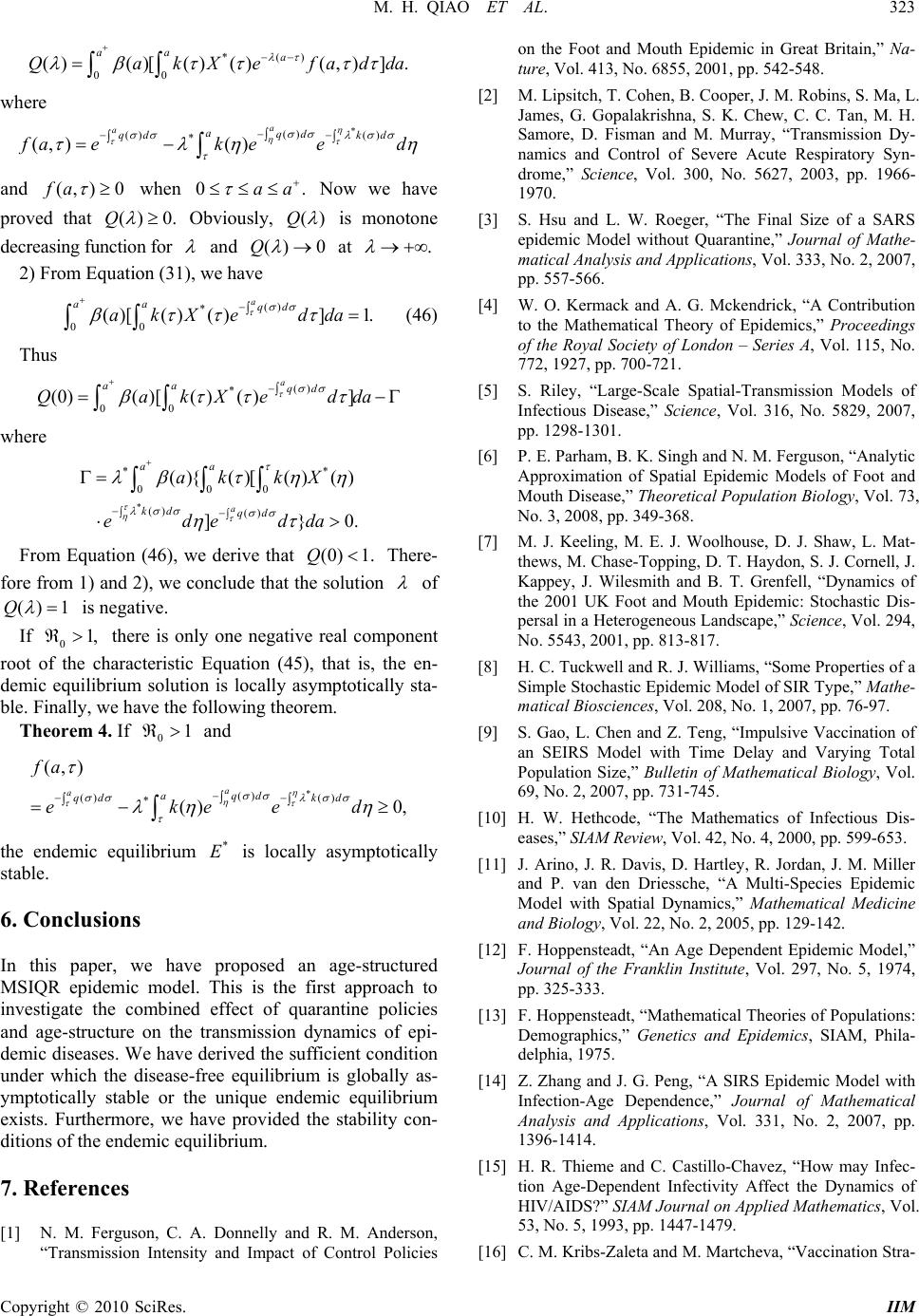 M. H. QIAO ET AL. 323 da *() 00 ()()[()()(,)] . aa a QakXefad where * () () () * (,)() a aaqd qd kd f aeke ed and (,)0fa Q when Now we have proved that 0aa . () 0. Obviously, (Q) is monotone decreasing function for and ()Q0 at . 2) From Equation (31), we have () * 00 ()[() ()]1. a aa qd akXedda (46) Thus () * 00 (0)()[( )( )] a aa qd QakXedd a * 0. where * * 000 () () (){()[() () ]} a aa kd qd ak kX ededda From Equation (46), we derive that There- fore from 1) and 2), we conclude that the solution (0)1.Q of () 1Q is negative. If there is only one negative real component root of the characteristic Equation (45), that is, the en- demic equilibrium solution is locally asymptotically sta- ble. Finally, we have the following theorem. 01, Theorem 4. If and 01 * () () () * (, ) () 0, a aaqd qd kd fa ekeed the endemic equilibrium is locally asymptotically stable. * E 6. Conclusions In this paper, we have proposed an age-structured MSIQR epidemic model. This is the first approach to investigate the combined effect of quarantine policies and age-structure on the transmission dynamics of epi- demic diseases. We have derived the sufficient condition under which the disease-free equilibrium is globally as- ymptotically stable or the unique endemic equilibrium exists. Furthermore, we have provided the stability con- ditions of the end e mic equilibrium. 7 . References [1] N. M. Ferguson, C. A. Donnelly and R. M. Anderson, “Transmission Intensity and Impact of Control Policies on the Foot and Mouth Epidemic in Great Britain,” Na- ture, Vol. 413, No. 6855, 2001, pp. 542-548. [2] M. Lipsitch, T. Cohen, B. Cooper, J. M. Robins, S. Ma, L. James, G. Gopalakrishna, S. K. Chew, C. C. Tan, M. H. Samore, D. Fisman and M. Murray, “Transmission Dy- namics and Control of Severe Acute Respiratory Syn- drome,” Science, Vol. 300, No. 5627, 2003, pp. 1966- 1970. [3] S. Hsu and L. W. Roeger, “The Final Size of a SARS epidemic Model without Quarantine,” Journal of Mathe- matical Analysis and Applications, Vol. 333, No. 2, 2007, pp. 557-566. [4] W. O. Kermack and A. G. Mckendrick, “A Contribution to the Mathematical Theory of Epidemics,” Proceedings of the Royal Society of London – Series A, Vol. 115, No. 772, 1927, pp. 700-721. [5] S. Riley, “Large-Scale Spatial-Transmission Models of Infectious Disease,” Science, Vol. 316, No. 5829, 2007, pp. 1298-1301. [6] P. E. Parham, B. K. Singh and N. M. Ferguson, “Analytic Approximation of Spatial Epidemic Models of Foot and Mouth Disease,” Theoretical Population Biology, Vol. 73, No. 3, 2008, pp. 349-368. [7] M. J. Keeling, M. E. J. Woolhouse, D. J. Shaw, L. Mat- thews, M. Chase-Topping, D. T. Haydon, S. J. Cornell, J. Kappey, J. Wilesmith and B. T. Grenfell, “Dynamics of the 2001 UK Foot and Mouth Epidemic: Stochastic Dis- persal in a Heterogeneous Landscape,” Science, Vol. 294, No. 5543, 2001, pp. 813-817. [8] H. C. Tuckwell and R. J. Williams, “Some Properties of a Simple Stochastic Epidemic Model of SIR Type,” Mathe- matical Biosciences, Vol. 208, No. 1, 2007, pp. 76-97. [9] S. Gao, L. Chen and Z. Teng, “Impulsive Vaccination of an SEIRS Model with Time Delay and Varying Total Population Size,” Bulletin of Mathematical Biology, Vol. 69, No. 2, 2007, pp. 731-745. [10] H. W. Hethcode, “The Mathematics of Infectious Dis- eases,” SIAM Review, Vol. 42, No. 4, 2000, pp. 599-653. [11] J. Arino, J. R. Davis, D. Hartley, R. Jordan, J. M. Miller and P. van den Driessche, “A Multi-Species Epidemic Model with Spatial Dynamics,” Mathematical Medicine and Biology, Vol. 22, No. 2, 2005, pp. 129-142. [12] F. Hoppensteadt, “An Age Dependent Epidemic Model,” Journal of the Franklin Institute, Vol. 297, No. 5, 1974, pp. 325-333. [13] F. Hoppensteadt, “Mathematical Theories of Populations: Demographics,” Genetics and Epidemics, SIAM, Phila- delphia, 1975. [14] Z. Zhang and J. G. Peng, “A SIRS Epidemic Model with Infection-Age Dependence,” Journal of Mathematical Analysis and Applications, Vol. 331, No. 2, 2007, pp. 1396-1414. [15] H. R. Thieme and C. Castillo-Chavez, “How may Infec- tion Age-Dependent Infectivity Affect the Dynamics of HIV/AIDS?” SIAM Journal on Applied Mathematics, Vol. 53, No. 5, 1993, pp. 1447-1479. [16] C. M. Kribs-Zaleta and M. Martcheva, “Vaccination Stra- Copyright © 2010 SciRes. IIM 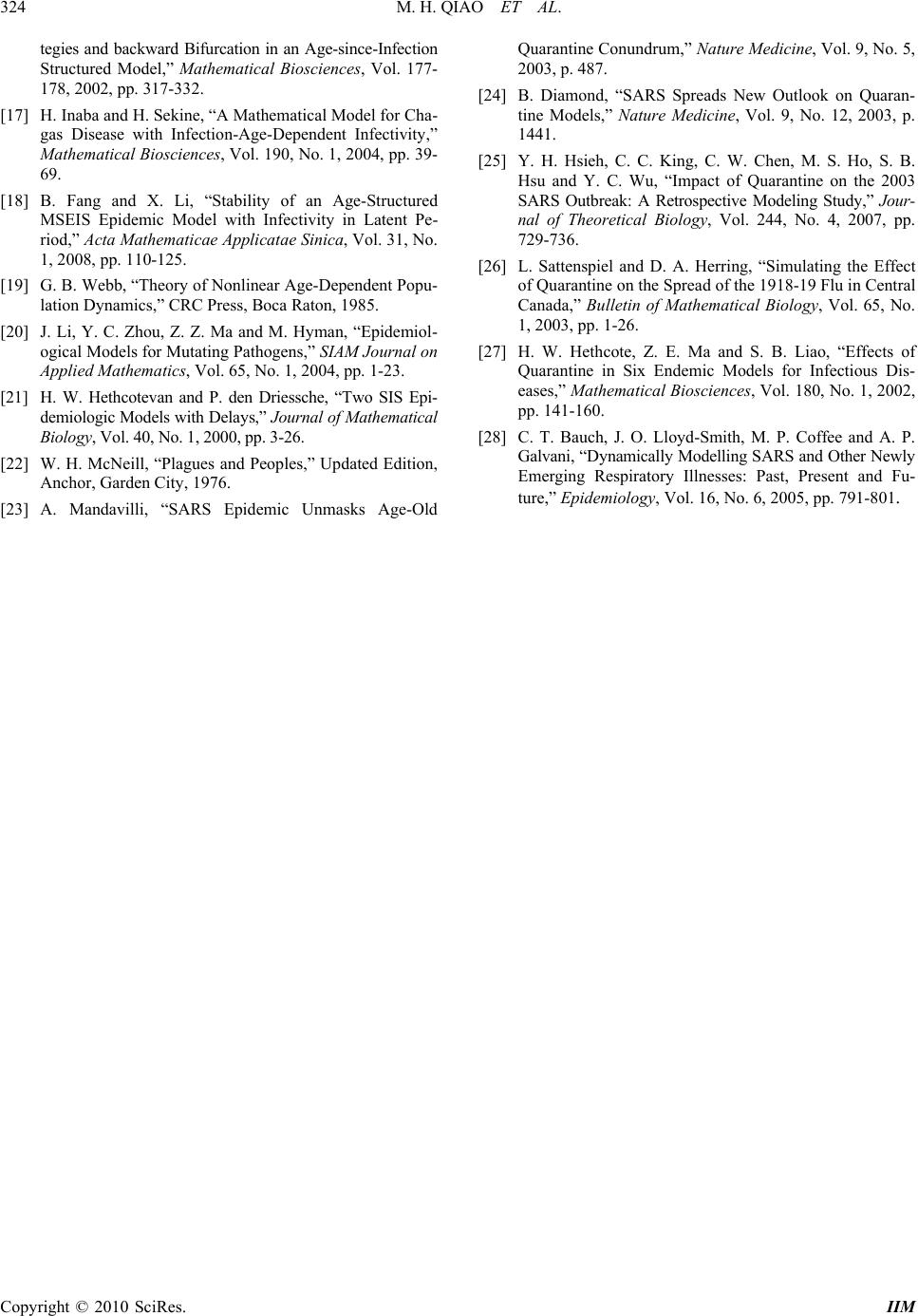 324 M. H. QIAO ET AL. Copyright © 2010 SciRes. IIM tegies and backward Bifurcation in an Age-since-Infection Structured Model,” Mathematical Biosciences, Vol. 177- 178, 2002, pp. 317-332. [17] H. Inaba and H. Sekine, “A Mathematical Model for Cha- gas Disease with Infection-Age-Dependent Infectivity,” Mathematical Biosciences, Vol. 190, No. 1, 2004, pp. 39- 69. [18] B. Fang and X. Li, “Stability of an Age-Structured MSEIS Epidemic Model with Infectivity in Latent Pe- riod,” Acta Mathematicae Applicatae Sinica, Vol. 31, No. 1, 2008, pp. 110-125. [19] G. B. Webb, “Theory of Nonlinear Age-Dependent Popu- lation Dynamics,” CRC Press, Boca Raton, 1985. [20] J. Li, Y. C. Zhou, Z. Z. Ma and M. Hyman, “Epidemiol- ogical Models for Mutating Pathogens,” SIAM Journal on Applied Mathematics, Vol. 65, No. 1, 2004, pp. 1-23. [21] H. W. Hethcotevan and P. den Driessche, “Two SIS Epi- demiologic Models with Delay s,” Journal of Mathematical Biology, Vol. 40, No. 1, 2000, pp. 3-26. [22] W. H. McNeill, “Plagues and Peoples,” Updated Edition, Anchor, Garden City, 1976. [23] A. Mandavilli, “SARS Epidemic Unmasks Age-Old Quarantine Conundrum,” Nature Medicine, Vol. 9, No. 5, 2003, p. 487. [24] B. Diamond, “SARS Spreads New Outlook on Quaran- tine Models,” Nature Medicine, Vol. 9, No. 12, 2003, p. 1441. [25] Y. H. Hsieh, C. C. King, C. W. Chen, M. S. Ho, S. B. Hsu and Y. C. Wu, “Impact of Quarantine on the 2003 SARS Outbreak: A Retrospective Modeling Study,” Jour- nal of Theoretical Biology, Vol. 244, No. 4, 2007, pp. 729-736. [26] L. Sattenspiel and D. A. Herring, “Simulating the Effect of Quarantine on the Spread of the 1918-19 Flu in Central Canada,” Bulletin of Mathematical Biology, Vol. 65, No. 1, 2003, pp. 1-26. [27] H. W. Hethcote, Z. E. Ma and S. B. Liao, “Effects of Quarantine in Six Endemic Models for Infectious Dis- eases,” Mathematical Biosciences, Vol. 180, No. 1, 2002, pp. 141-160. [28] C. T. Bauch, J. O. Lloyd-Smith, M. P. Coffee and A. P. Galvani, “Dynamically Modelling SARS and Other Newly Emerging Respiratory Illnesses: Past, Present and Fu- ture,” Epidemiology, Vol. 16, No. 6, 2005, pp. 791-801. |

